53e. The Cold War Continues
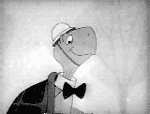
Cartoons of the unflappable Bert the Turtle warned American children everywhere during the Cold War to "duck and cover" in the event of a nuclear blast. Although these measures would have proved useless, schools vigorously pursued "duck and cover" drills in which children clambered beneath their desks.
The end of the Korean War in 1953 by no means brought an end to global hostilities.
As the British and French Empires slowly yielded to independence movements, a new Third World emerged. This became the major battleground of the Cold War as the United States and the Soviet Union struggled to bring new nations into their respective orbits. Across the Third World, the two superpowers squared off through proxy armies.
The United States's recognition of Israel in 1948 created a strong new ally, but created many enemies. Arab nations, enraged by American support for the new Jewish state, found supportive ears in the Soviet Union.
When Egyptian President Gamal Abdel Nasser sought to strengthen ties with the Soviet bloc, the United States withdrew its pledge to help Nasser construct the all-important Aswan Dam. Nasser responded by nationalizing the Suez Canal, an action that compelled British, French, and Israeli armies to invade Egypt.
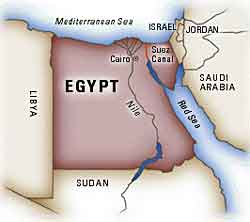
Egyptian president Gamal Abder Nasser's 1956 nationalization of the Suez Canal, crippled the ability of Great Britain and France to trade internationally. As a result, the two countries allied with Israel to attack Egypt.
The Eisenhower Doctrine
The Western alliance was threatened as President Dwight Eisenhower called upon Britain and France to show restraint. With Soviet influence growing in the oil-rich region, Ike issued the Eisenhower Doctrine, which pledged American support to any governments fighting communist insurgencies in the Middle East. Making good on that promise, he sent over 5,000 marines to Lebanon to forestall an anti-Western takeover.
Asia provided more challenges for American containment policy. China was flexing its muscles on Taiwan by threatening the takeover of the Taiwanese islands of Quemoy and Matsu. United States Secretary of State John Foster Dulles chose to follow a strategy of brinkmanship. He told China that any aggressive actions toward the islands would be met by force from the United States.
In a grown-up version of the children's game of chicken, Dulles hoped to avoid war by threatening war. The Chinese shelled the islands to save face, but no takeover occurred.
To the south, communist revolutionary Ho Chi Minh successfully defeated the French colonial army to create the new nation of Vietnam. American commitment to the containment of communism led to a protracted involvement that would become the Vietnam War.
Ethel and Julius Rosenberg Sentencing Excerpts
One 1950s Cold War catalyst of fear was the capture and conviction of Ethel and Julius Rosenberg for selling nuclear secrets to the Soviet Union. Although the FBI advised sparing Ethel Rosenberg's life (she had two children), Judge Irving Kaufman refused to do so and sentenced her to death with her husband. The trial and sentencing were controversial, partly due to charges of anti-Semitism.
Citizens of this country who betray their fellow-countrymen can be under none of the delusions about the benignity of Soviet power that they might have been prior to World War II. The nature of Russian terrorism is now self-evident.
I consider your crime worse than murder. Plain, deliberate, contemplated murder is dwarfed in magnitude by comparison with the crime you have committed. In committing the act of murder, the criminal kills only his victim. The immediate family is brought to grief, and when justice is meted out the chapter is closed. But in your case, I believe your conduct in putting into the hands of the Russians the A-bomb years before our best scientists predicted Russia would perfect the bomb has already caused, in my opinion, the Communist aggression in Korea, with the resultant casualties exceeding 50,000 and who knows but that millions more of innocent people may pay the price of your treason. Indeed, by your betrayal you undoubtedly have altered the course of history to the disadvantage of our country.
No one can say that we do not live in a constant state of tension. We have evidence of your treachery all around us every day — for the civilian defense activities throughout the nation are aimed at preparing us for an atom bomb attack. Nor can it be said in mitigation of the offense that the power which set the conspiracy in motion and profited from it was not openly hostile to the United States at the time of the conspiracy. If this was your excuse the error of your ways in setting yourselves above our properly constituted authorities and the decision of those authorities not to share the information with Russia must now be obvious ....
In the light of this, I can only conclude that the defendants entered into this most serious conspiracy against their country with full realization of its implications ....
The statute of which the defendants at the bar stand convicted is clear. I have previously stated my view that the verdict of guilty was amply justified by the evidence. In the light of the circumstances, I feel that I must pass such sentence upon the principals in this diabolical conspiracy to destroy a God-fearing nation, which will demonstrate with finality that this nation's security must remain inviolate; that traffic in military secrets, whether promoted by slavish devotion to a foreign ideology or by a desire for monetary gains, must cease.
The evidence indicated quite clearly that Julius Rosenberg was the prime mover in this conspiracy. However, let no mistake be made about the role which his wife, Ethel Rosenberg, played in this conspiracy. Instead of deterring him from pursuing his ignoble cause, she encouraged and assisted the cause. She was a mature woman — almost three years older than her husband and almost seven years older than her younger brother. She was a full-fledged partner in this crime.
Indeed, the defendants, Julius and Ethel Rosenberg, placed their devotion to their cause above their own personal safety and were conscious that they were sacrificing their own children should their misdeeds be detected — all of which did not deter them from pursuing their course. Love for their cause dominated their lives — it was even greater than their love for their children.
– excerpt from Judge Kaufman's sentencing of convicted spies Julius and Ethel Rosenberg, in which he sentenced them to death (April 5, 1951)
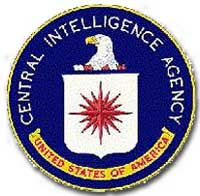
The CIA was formed after World War II to monitor the potential threat of communist countries.
The CIA
In the aftermath of World War II, the United States created a new weapon to assist in fighting the Cold War: the Central Intelligence Agency. In addition to gathering information on Soviet plans and maneuvers, the CIA also involved itself in covert operations designed to prevent communist dictators from rising to power.
The first such instance occurred in Iran, when Iranian Prime Minister Mohammed Mossadegh nationalized British Petroleum. Fearing Soviet influence in the powerful oil nation, the CIA recruited a phony mob to drive off Mossadegh and return the American-backed Shah Mohammad Reza Pahlavi to power.
When Jacobo Arbenz came to power in Guatemala, he promised to relieve the nation's impoverished farmers by seizing land held by the American-owned United Fruit Company and redistributing it to the peasants. With the support of American air power, a CIA-backed band of mercenaries overthrew Arbenz and established a military dictatorship.

Beginning on July 4, 1956, U-2 spy planes infiltrated Soviet airspace to take photos and determine the number of bomber planes possessed by the USSR. The secret flights lasted until 1960, when a U-2 plane was shot down.
Throughout Latin America, the United States was seen as a brutal defender of thuggish autocrats at the expense of popularly elected leaders. Fidel Castro capitalized on this sentiment by overthrowing U.S.-backed dictator Fulgencio Batista from power in Cuba in January 1959.
Policy of Mass Retaliation
Relations remained icy between the United States and the Soviet Union. Relying on the knowledge that the United States had a much larger nuclear arsenal than the Soviet Union, Eisenhower and Dulles announced a policy of massive retaliation. Any attack by the Soviets on the United States or its allies would be met with nuclear force.
The Soviet crackdown on the Hungarian Uprising of 1956 further strained relations. In an effort to reduce tensions, Eisenhower offered an "open skies" proposal to Soviet leader Nikita Khrushchev. Planes from each nation would be permitted to fly over the other to inspect nuclear sites. But Khrushchev declined the offer. A summit conference between Eisenhower and Khrushchev was canceled in 1960 when the Soviets shot down an American U-2 spy plane piloted by Gary Powers.
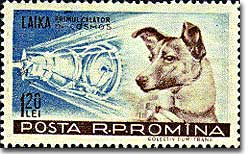
This stamp commemorates Laika, the dog that was sent into space on the second Soviet satellite, Sputnik II, in November 1957. The launch of the first Sputnik earlier that year triggered a massive American effort to catch up to Soviet space technology, culminating in 1969 with the U.S. mission to the Moon.
Despite the passing of Joseph Stalin, Americans continued to view the Soviet Union as the Great Red Menace.
When the USSR put Sputnik into orbit in 1957, panic struck the American heartland. Thousands rushed to Sears and Roebuck to purchase bomb shelter kits, and Congress responded by creating the National Aeronautical and Space Administration and by appropriating funds for science education.
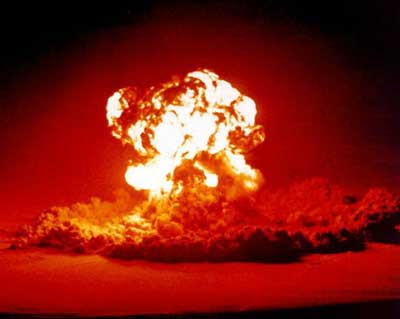
The mushroom cloud above was photographed in a 1956 nuclear test known as Operation Plumbbob. The possibility of nuclear war loomed over terrified Americans in the 1950s.
Not even outer space was safe from Cold War confrontation.







